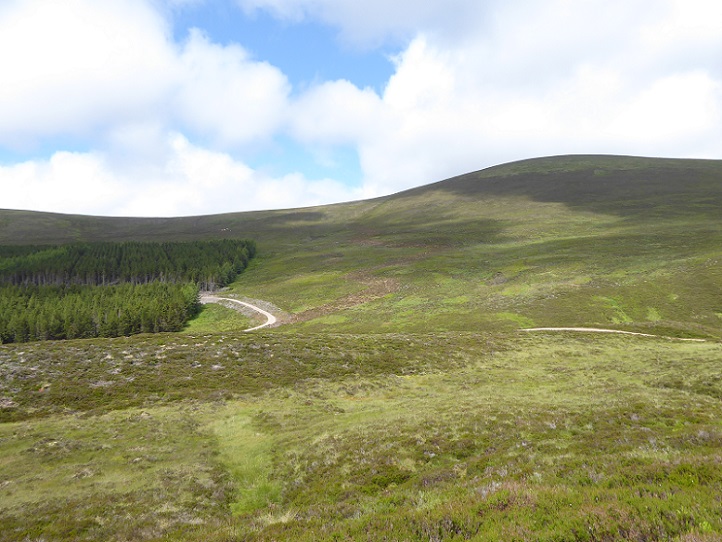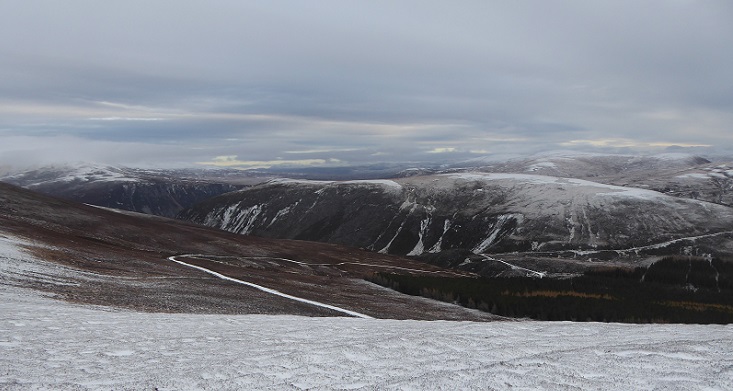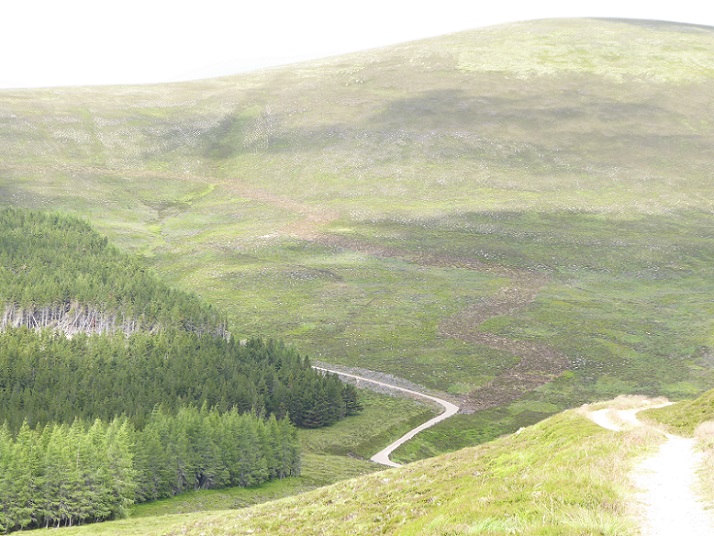
Following my post on the failed restoration of the Beauly Denny powerline access tracks (see here), someone asked on twitter “how would you have done this differently”? The answer lies just over the hill on the southern face of Carn Dearg Mor above Glen Feshie. There, Wild Land Ltd is in the process of removing a hill road. Already you could walk past and not see the scar.


Because this was a longstanding road, there was no “spare” vegetation to cover its surface once this had been re-moulded to fit back into the landscape. The pockmarks on the slope show where vegetation has been “borrowed” and used to cover the track. Because the areas of borrowed vegetation are small and well spaced, each should be re-colonised by the plants surrounding them in a year or two despite the short growing season at this altitude (600-700m). That process will have been assisted by the work having been carried out fairly early in the growing season this year.
The Beauly Denny restoration should have been far simpler than that on Carn Dearg Mor, as the access roads were supposed to be only temporary and it also lies at a lower altitude. Had vegetation along the line of the access roads been removed carefully and stored properly, it could have simply been replaced once the line of the road had been re-moulded to fit the landscape. The scars should then have disappeared in a year or so. Instead five years later the scar is almost as prominent as it was when the roads were constructed:

Had SSE ensured suitably skilled contractors were employed to work on the construction and restoration of the Beauly Denny access roads, none of the landscape scarring at the Drumochter need have occurred. Remedial work could still start tomorrow if the Scottish Government had the political will to hold SSE to account. There is plenty of vegetation on the surrounding ground that could be “borrowed” to help resurface these roads and there would be even more if the muirburn that is scarring the hillside above was stopped. But first the surface of the access road needs to be re-moulded to fit the contours of the hillside, removing the straight line that currently cuts across it.
Hill roads have been proliferating across Scotland over the last forty years and while the Cairngorms National Park Authority has now adopted a presumption against new ones in its Local Development Plan, they have no plans to restore past landscape damage. Since the National Trust for Scotland bought Mar Lodge in the 1990s and removed the road high up on Beinn a Bhuird (see here), no-one else had either until WildLand Ltd decided to remove some of the worst landscape scars on the estates it had bought: Glenfeshie, Glentromie, Gaick, Killiehuntly, Lynaberack.
The work Wildland Ltd are doing to restore hill roads should, in my view, be publicised more widely and inspire a programme to remove unsightly and damaging roads across the National Park. It also demonstrates that given the will (its taken a private landowner Anders Povlsen to show what can be done) and the right contractor, much of the damage that has been caused by poorly planned and shoddy work – whether at Cairn Gorm or Drumochter – could and should have been avoided.

Yes I fully agree with your comments on hill tracks. Anders Polvsen and his team are to be congratulated on their work in re-profiling old roads and removing and restoring those which are no longer required. The quality of this type of work depends largely on the skill of the machine operators and the local contractor Duncan Grant should be given special mention. It is worth noting that the main road up the Slochd Mor was re-routed and improved over 20 years ago. In a very short period the vegetation had fully regrown over the bare areas and the old road no longer visible.
However, the situation in the Upper Feshie is less than satisfactory. Up until the 90’s 4×4 vehicles could only go as far as the Allt na Leum where the narrow gorge restricted further progress. As the area was designated as part of the Cairngorms National Nature Reserve ( remember it ? ) , the estate asked for permission to widen the existing pony path to allow hill vehicle access to the Upper Feshie. This was granted by The Highland Council and Scottish Natural Heritage , on the spurious basis that the estate would kill more deer – this was many years before Mr Polvsen arrived in Glen Feshie. The result now, is that hill vehicles, Argocats, Quad Bikes and tracked vehicles have virtually destroyed the fine old pony path which went as far as the Ruidhe Eindart, by tearing up the peaty vegetation and impeding the old drainage lines and spoiling the fine Feshie – Geldie crossing for walkers and cyclists. It would be pointless do any remedial work here until the use of hill vehicles is curtailed.
Your are right to be concerned about the situation in the upper Feshie and the ATV damage, including to the beautiful old path there, is indeed serious. Wildland proposed to deal with that a couple of years ago by building a track but that would have allowed easy access into the heart of the Cairngorms and they withdraw their application for planning permission. The situation since has been in limbo. The issue is that to bring down deer numbers and allow the land to regenerate, the estate needs some vehicular access to hill areas. Instead of what it inherited, they have tried to rationalise the track system and improve the design and build of tracks where they remain but they have also wanted to access the Upper Feshie because of the high deer numbers there. A solution that avoids the need for tracks in the most important areas of wild land is now possible because NTS are now reducing deer numbers on the Mar Lodge Estate much more effectively than recently. Deer from Mar were from the Geldie down the Feshie and eating all the regeneration there. If Atholl Estates, were also to reduce deer to the same extent – they have started to do so – that would also reduce the numbers of deer that move into the Upper Feshie and the need to drive up the glen in ATVs to cull them. But what is also needed is a change in the law, as recommended by the Deer Working Group, so that stags can be shot through the winter. That would greatly reduce the need for Wildland, NTS etc to go into wild land areas to cull deer: instead they could wait until the deer were forced by snow onto the more accessible lower ground.